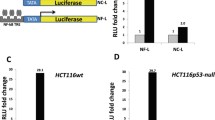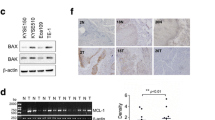Abstract
Chemosensitivity to anticancer drugs was compared between two human esophageal carcinoma cell lines, T.Tn and YES-6 cells. T.Tn cells were more resistant than YES-6 cells to peplomycin (PEP) but not to the other anticancer drugs such as camptothecin, mitomycin C and cytosine arabinoside. Western blot analysis showed higher expression levels of m-calpain and activated μ-calpain in T.Tn cells than in YES-6 cells. On the other hand, YES-6 cells showed a high expression level of calpastatin, which is a calpain-specific endogenous inhibitor. To investigate whether calpain activity was involved in the chemosensitivity, T.Tn cells were transfected with calpastatin cDNA in an inducible expression vector. The induction of calpastatin was accompanied by increased chemosensitivity to PEP. The increases in calpastatin levels were followed by serial increases in the expression levels of NF-κB p65 and Fas. Since purified m- or μ-calpain degraded NF-κB p65 in vitro, it is possible that calpastatin suppressed calpain-mediated degradation of NF-κB p65. Fas ligand (Fas-L) protein levels increased after treatment of the parental T.Tn and calpastatin-transfected cells with PEP, suggesting the synergism between calpastatin-induced Fas and PEP-induced Fas-L. These results suggest that calpain/calpastatin expression levels are effective markers for predicting the sensitivity of human esophageal carcinoma cells to PEP.
Similar content being viewed by others
Abbreviations
- ALLN:
-
N-acetyl-Leu-Leu-norleucinal;
- AraC:
-
cytosine arabinoside;
- BLM:
-
bleomycin;
- CDDP (cisplatin):
-
cis-diaminedichloroplatinum;
- CPT:
-
camptothecin;
- Dex:
-
dexamethasone;
- DMSO:
-
dimethylsulfoxide;
- EMSA:
-
eletrophoretic mobility shift assay;
- Fas-L:
-
Fas ligand;
- 5-FU:
-
5-fluorouracil;
- ICE-inhibitor III:
-
interleukin-1β converting enzyme inhibitor III (benzyloxycarbonyl-Asp-2,6-dichlorobenzoyloxymethylketone);
- IR:
-
ionizing radiation;
- lactacystin:
-
clasto-lactacystin β-lactone;
- MIT:
-
mitoxantrone;
- MMC:
-
mitomycin C;
- MTT:
-
3-(4,5-dimethylthiozol-2-yl)-2,5-diphenyltetrazolium bromide;
- MTX:
-
methotrexate;
- PBS:
-
phosphate-buffered saline;
- PEP:
-
peplomycin;
- RT-PCR:
-
reverse transcription-PCR;
- S.D.:
-
standard deviation;
- TNF-α:
-
tumor necrosis factor-α;
- VCR:
-
vincristine;
- VP16:
-
etoposide
References
Isono K, Ochiai T. Recent advances of treatment of cancer of the esophagus (review). Ann Cancer Res Ther 1992; 1: 9–16.
Houghton JA, Weiss KD, Williams LG, Torrance PM, Houghton PJ. Relationship between 5-fluoro-2’-deoxyuridylate, 2′-deoxyuridylate, and thymidylate synthase activity subsequent to 5-fluorouracil administration, in xenografts of human colon adenocarcinomas. Biochem Pharmacol 1986; 35: 1351–1358.
Aschele C, Sobrero A, Faderan MA, Bertino JR. Novel mechanism(s) of resistance to 5-fluorouracil in human colon cancer (HCT-8) sublines following exposure to two different clinically relevant dose schedules. Cancer Res 1992; 52: 1855–1864.
Oka S. A review of clinical studies of bestatin. Recent Results Cancer Res 1980; 75: 126–132.
Bunz F, Dutriaux A, Lengauer C, et al. Requirement for p53 and p21 to sustain G2 arrest after DNA damage. Science 1998; 282: 1497–1501.
el-Deiry WS, Tokino T, Velculescu VE, et al. WAF1, a potential mediator of p53 tumor suppression. Cell 1993; 75: 817–825.
Miyashita T, Reed JC. Tumor suppressor p53 is a direct transcriptional activator of the human bax gene. Cell 1995; 80: 293–299.
Oda K, Arakawa H, Tanaka T, et al. p53AIP1, a potential mediator of p53-dependent apoptosis, and its regulation by Ser-46-phosphorylated p53. Cell 2000; 102: 849–862.
Oda E, Ohki R, Murasawa H, et al. Noxa, a BH3-only member of the Bcl-2 family and candidate mediator of p53-induced apoptosis. Science 2000; 288: 1053–1058.
Polyak K, Xia Y, Zweier JL, Kinzler KW, Vogelstein B. A model for p53-induced apoptosis. Nature 1997; 389: 300–305.
Hellin AC, Calmant P, Gielen J, Bours V, Merville MP. Nuclear factor-κB-dependent regulation of p53 gene expression induced by daunomycin genotoxic drug. Oncogene 1998; 16: 1187–1195.
Tergaonkar V, Pando M, Vafa O, Wahl G, Verma I. p53 stabilization is decreased upon NFκB activation: A role for NFκB in acquisition of resistance to chemotherapy. Cancer Cell 2002; 1: 493–503.
Gilmore TD. The Rel/NF-κB signal transduction pathway: Introduction. Oncogene 1999; 18: 6842–6844.
Canty TG Jr, Boyle EM Jr, Farr A, Morgan EN, Verrier ED, Pohlman TH. Oxidative stress induces NF-κB nuclear translocation without degradation of IκBα. Circulation 1999; 9: II 361–364.
Ravi R, Mookerjee B, van Hensbergen Y, et al. p53-mediated repression of nuclear factor-κB RelA via the transcriptional integrator p300. Cancer Res 1998; 58: 4531–4536.
Ikeda A, Sun X, Li Y, et al. p300/CBP-dependent and –independent transcriptional interference between NF-κB RelA and p53. Biochem Biophys Res Commun 2000; 272: 375–379.
Kuhnel F, Zender L, Paul Y, et al. NFκB mediates apoptosis through transcriptional activation of Fas (CD95) in adenoviral hepatitis. J Biol Chem 2000; 275: 6421–6427.
Cohen PL, Eisenberg RA. Lpr and gld: Single gene models of systemic autoimmunity and lymphoproliferative disease. Annu Rev Immunol 1991; 9: 243–269.
Kinoshita H, Yoshikawa H, Shiiki K, Hamada Y, Nakajima Y, Tasaka K. Cisplatin (CDDP) sensitizes human osteosarcoma cell to Fas/CD95-mediated apoptosis by down-regulating FLIP-L expression. Int J Cancer 2000; 88: 986–991.
Mizutani Y, Wu XX, Yoshida O, Shirasaka T, Bonavida,B. Chemoimmunosensitization of the T24 human bladder cancer line to Fas-mediated cytotoxicity and apoptosis by cisplatin and 5-fluorouracil. Oncol Rep 1999; 6: 979–982.
Han Y, Weinman S, Boldogh I, Walker RK, Brasier AR. Tumor necrosis factor-α-inducible IκBα proteolysis mediated by cytosolic m-calpain. A mechanism parallel to the ubiquitin-proteasome pathway for nuclear factor-κB activation. J Biol Chem 1999; 274: 787–794.
Hiwasa T. Substrates for calpain, proteasome and caspase. Recent Res Devel Biochem 2003; 4: 629–642.
Lee FY, Kim DW, Karmin JA, et al. μ-calpain regulates receptor activator of NF-κB Ligand (RANKL)-supported osteoclastogenesis via NF-κB activation in RAW 264.7 cells. J Biol Chem 2005; 280: 29929–29936.
Sorimachi H, Suzuki K. The structure of calpain. J Biochem 2001; 129: 653–664.
Dear TN, Boehm T. Identification and characterization of two novel calpain large subunit genes. Gene 2001; 274: 245–252.
Ohno S, Emori Y, Imajoh S, Kawasaki H, Kisaragi, M, Suzuki K. Evolutionary origin of a calcium-dependent protease by fusion of genes for a thiol protease and a calcium-binding protein? Nature 1984; 312: 566–570.
Murachi T, Tanaka K, Hatanaka M, Murakami T. Intracellular Ca2+-dependent protease (calpain) and its high-molecular-weight endogenous inhibitor (calpastatin). Adv Enzyme Regul 1980; 19: 407–424.
Shimada H, Shimizu T, Ochiai T, et al. Preclinical study of adenoviral p53 gene therapy for esophageal cancer. Surg Today 2001; 31: 597–604.
Oka M, Hirose K, Iizuka N, et al. Cytokine mRNA expression patterns in human esophageal cancer cell lines. J Interferon Cytokine Res 1995; 15: 1005–1009.
Mosmann T. Rapid colorimetric assay for cellular growth and survival: Application to proliferation and cytotoxicity assays. Immunol Methods 1983; 65: 55–63.
Hiwasa T, Shimada H, Sakaida T, et al. Drug-sensitivity pattern analysis of study of functional relationship between gene products. FEBS Lett 2003; 552: 177–183.
Hiwasa T, Sawada T, Sakiyama S. Cysteine proteinase inhibitors and ras gene products share the same biological activities including transforming activity toward NIH3T3 mouse fibroblasts and the differentiation-inducing activity toward PC12 rat pheochromocytoma cells. Carcinogenesis 1990; 11: 75–80.
Hiwasa T. Induction of apoptosis by a calpain stimulator, ONO-3403. Apoptosis 1996; 1: 75–80.
Hiwasa T, Sakiyama S. Nuclear localization of procathepsin L/MEP in ras-transformed mouse fibroblasts. Cancer Lett 1996; 99: 87–91.
Inomata M, Nakamura M, Imajoh-Ohmi S, Kawashima S. A variety of calpain/calpastatin systems in mammalian erythrocytes. Biochim Biophys Acta 1993; 1178: 207–214.
Saido TC, Nagao S, Shiramine M, et al. Autolytic transition of mu-calpain upon activation as resolved by antibodies distinguishing between the pre- and post-autolysis forms. J Biochem 1992; 111: 81–86.
Sakao E, Ishihara A, Horikawa K, et al. Two-peaked synchronization in day/night expression rhythms of the fibrinogen gene cluster in the mouse liver. J Biol Chem 2003; 278: 30450–30457.
Hitomi K, Yokoyama A, Maki M. Expression of biologically active human calpastatin in baculovirus-infected insect cells and in Escherichia coli. Biosci Biotechnol Biochem 1998; 62: 136–141.
Hiwasa T, Ma J, Ike Y, Katunuma N, Sakiyama S. Increase of cyclin B by overexpression of cystatin α. Cell Biochem Funct 1995; 13: 293–296.
Hiwasa T, Nakata M, Nakata M, et al. Regulation of transformed state by calpastatin via PKCɛ in NIH3T3 mouse fibroblasts. Biochem Biophys Res Commun 2002; 290: 510–517.
Mauxion F, Sen R. Alteration of a single nucleotide allows efficient binding of H2TF1/KBF1 to the immunoglobulin κ enhancer B motif. Mol Cell Biol 1989; 9: 3548–3552.
Kitagawa M, Oyama T, Kawashima T, et al. A human protein with sequence similarity to Drosophila mastermind coordinates the nuclear form of notch and a CSL protein to build a transcriptional activator complex on target promoters. Mol Cell Biol 2001; 21: 4337–4346.
Fujita T, Nolan GP, Liou H-C, Scott ML, Baltimore D. The candidate proto-oncogene bcl-3 encodes a transcriptional coactivator that activates through NF-κB p50 homodimers. Genes Develop 1993; 7: 1354–1363.
Chi X-J, Hiwasa T, Maki M, et al. Suppression of okadaic acid-induced apoptosis by overexpression of calpastatin in human UVr-1 cells. FEBS Lett 1999; 459: 391–394.
Suzuki K, Nakajima H, Kagami S, et al. Proteolytic processing of Stat6 signaling in mast cells as a negative regulatory mechanism. J Exp Med 2002; 196: 27–38.
Shen J, Channavajhala P, Seldin DC, Sonenshein GE. Phosphorylation by the protein kinase CK2 promotes calpain-mediated degradation of IκBα. J Immunol 2001; 167: 4919–4925.
Bos JL, ras oncogenes in human cancer: A review. Cancer Res 1989; 49: 4682–4689.
Tamura K, Araki Y, Tateyama H, Maeda M, Seita M. Phase II trial of cis-diamminedichloroplatinum (cis-platinum), vincristine, and peplomycin for advanced squamous cell carcinoma. J Surg Oncol 1987; 35: 241–244.
Ghosh S, Mendoza T, Ortiz LA, et al. Bleomycin sensitivity of mice expressing dominant-negative p53 in the lung epithelium. Am J Respir Crit Care Med 2002; 166: 890–897.
Ueta E, Yoneda K, Kimura T, et al. Mn-SOD antisense upregulates in vivo apoptosis of squamous cell carcinoma cells by anticancer drugs and γ-rays regulating expression of the BCL-2 family proteins, COX-2 and p21. Int J Cancer 2001; 94: 545–550.
Yang HL, Dong YB, Elliott MJ, Liu TJ, McMasters KM. Caspase activation and changes in Bcl-2 family member protein expression associated with E2F-1-mediated apoptosis in human esophageal cancer cells. Clin Cancer Res 2000; 6: 1579–1589.
Sakaida T, Iwadate Y, Yamaji S, et al. Acquisition of drug resistance by constitutive suppression of NF-κB in ras-transformed NIH3T3 mouse fibroblasts. Int J Oncol 2003; 23: 1071–1077.
Zheng Y, Ouaaz F, Bruzzo P, Singh V, Gerondakis S, Beg AA. NF-κB RelA (p65) is essential for TNF-α-induced fas expression but dispensable for both TCR-induced expression and activation-induced cell death. J Immunol 2001; 166: 4949–4957.
Muraki Y, Tateishi A, Seta C, et al. Fas antigen expression and outcome of oral squamous cell carcinoma. Int J Oral Maxillofac Surg 2000; 29: 360–365.
Okamura H, Morimoto H, Haneji T. Peplomycin-induced apoptosis in oral squamous carcinoma cells depends on bleomycin sensitivity. Oral Oncol 2001; 37: 379–385.
Furusaka T, Kida A, Iizuka N, Kikuchi K, Tomita H. Combination chemotherapy with CDDP, 5-FU and PEP in head and neck malignant tumors. Auris Nasus Larynx 1986; 13: Suppl. 1, S127–133.
Sakamoto K, Komatsu K, Matsumoto Y. The in vitro and in vivo antitumor effects of pepleomycin alone or in combination with radiation. Radiat Res 1985; 102: 224–231.
Eichhorst ST, Muerkoster S, Weigand MA, Krammer PH. The chemotherapeutic drug 5-fluorouracil induces apoptosis in mouse thymocytes in vivo via activation of the CD95 (APO-1/Fas) system. Cancer Res 2001; 61: 243–248.
Reap EA, Roof K, Maynor K, Borrero M, Booker J, Cohen PL. Radiation and stress-induced apoptosis: A role for Fas/Fas ligand interactions. Proc Natl Acad Sci USA 1997; 94: 5750–5755.
Kerr JF, Winterford CM, Harmon BV. Apoptosis. Its significance in cancer and cancer therapy. Cancer 1994; 73: 2013–2026.
Author information
Authors and Affiliations
Corresponding author
Additional information
This work was supported by the Grant for 21st Century COE (Center of Excellence) Program and a Grant-in-Aid for Scientific Research from the Ministry of Education, Culture, Sports, Science and Technology of Japan.
Rights and permissions
About this article
Cite this article
Liu, TL., Shimada, H., Ochiai, T. et al. Enhancement of chemosensitivity toward peplomycin by calpastatin-stabilized NF-κB p65 in esophageal carcinoma cells: possible involvement of Fas/Fas-L synergism. Apoptosis 11, 1025–1037 (2006). https://doi.org/10.1007/s10495-006-6353-y
Published:
Issue Date:
DOI: https://doi.org/10.1007/s10495-006-6353-y




